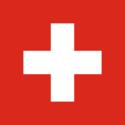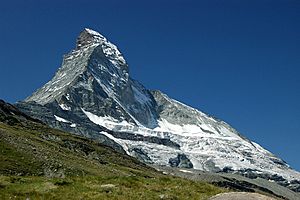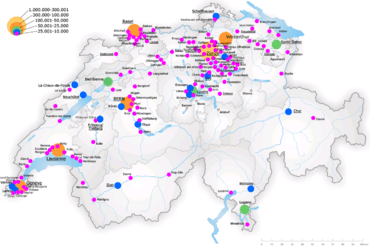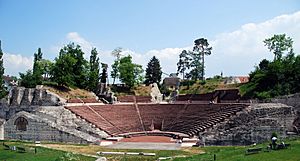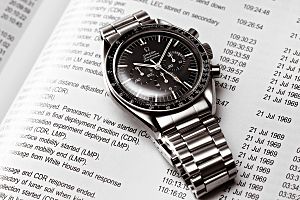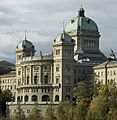Switzerland facts for kids
Quick facts for kids
Swiss Confederation
|
|
|---|---|
|
Motto: (unofficial)
"Unus pro omnibus, omnes pro uno" "One for all, all for one"
|
|
|
Anthem: "Swiss Psalm"
|
|
|
Location of Switzerland (green)
on the European continent (green and dark grey) |
|
| Capital |
46°57′N 7°27′E / 46.950°N 7.450°E |
| Largest city | Zurich |
| Official languages | |
| Religion
(2022)
|
|
| Demonym(s) | |
| Government | Federal assembly-independent directorial republic |
| Viktor Rossi | |
| Legislature | Federal Assembly |
| Council of States | |
| National Council | |
| History | |
|
• Founded
|
1 August 1291 |
|
• Sovereignty recognised (Peace of Westphalia)
|
24 October 1648 |
|
• Federal Treaty
|
7 August 1815 |
|
• Federal state
|
12 September 1848 |
| Area | |
|
• Total
|
41,285 km2 (15,940 sq mi) (132nd) |
|
• Water (%)
|
4.34 |
| Population | |
|
• 2023 estimate
|
|
|
• 2015 census
|
|
|
• Density
|
207/km2 (536.1/sq mi) (48th) |
| GDP (PPP) | 2024 estimate |
|
• Total
|
|
|
• Per capita
|
|
| GDP (nominal) | 2024 estimate |
|
• Total
|
|
|
• Per capita
|
|
| Gini (2023) | ▲ 31.5 medium |
| HDI (2022) | very high · 1st |
| Currency | Swiss franc (CHF) |
| Time zone | UTC+1 (CET) |
|
• Summer (DST)
|
UTC+2 (CEST) |
| Date format | dd.mm.yyyy (Anno Domini) |
| Driving side | right |
| Calling code | +41 |
| ISO 3166 code | CH |
| Internet TLD | .ch, .swiss |
Switzerland is a small country in Western Europe. Its official name is Confoederatio Helvetica. This is a Latin name, mostly used in official documents. Switzerland is made up of 26 smaller states called cantons.
Switzerland is famous for being neutral. This means it does not take sides in wars between other countries. Switzerland has been neutral for over 190 years. Many international groups, like the United Nations, have offices in Switzerland. The UN has a main office in Geneva.
There are four official languages in Switzerland: German, French, Italian, and Romansh. Some areas even speak two or three languages. About two-thirds of the people speak German. French is spoken in the west, Italian in the canton of Ticino, and Romansh in parts of Graubünden.
The capital city of Switzerland is Bern. The largest city is Zürich.
Switzerland shares borders with several countries. To the north is Germany. To the east are Austria and Liechtenstein. To the south is Italy. To the west is France.
Contents
- Geography of Switzerland
- Swiss Climate
- Environment and Nature
- Major Cities
- People of Switzerland
- History of Switzerland
- How Switzerland is Governed
- Swiss Economy
- Languages Spoken in Switzerland
- Religions in Switzerland
- Swiss Literature
- Popular Sports
- Swiss Food and Drink
- Related pages
- Images for kids
- See also
Geography of Switzerland
Switzerland covers an area of 41,285 square kilometers. The country is divided into 26 cantons. These include Aargau, Berne, Geneva, Graubünden, Lucerne, Ticino, and Zürich.
The central and southern parts of Switzerland have very tall mountains. About 60% of Switzerland is part of the Alps. Not many people live in these high mountain areas. The highest mountain is the Dufour Peak, which is 4,634 meters tall.
Many mountains have ice on them all year round. These large ice masses are called glaciers. Important rivers like the Rhine and Rhône start in the Swiss mountains.
Switzerland also has many beautiful lakes. The biggest lakes are in the north and west. These include Lake Geneva, Lake Zürich, Lake Neuchâtel, and Lake Constance.
The mountains in northern Switzerland are smaller and fewer. This is why most Swiss people live in cities and towns in the north. The Jura Mountains are located in the northwest of the country.
Swiss Climate
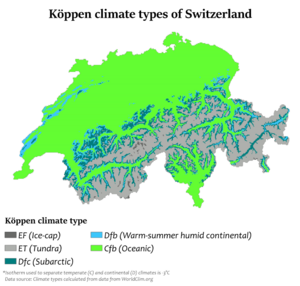
Switzerland generally has a temperate climate. However, the weather can change a lot from one place to another. You can find icy conditions on mountaintops and almost Mediterranean climate weather in the very south.
Summers are often warm and humid, with regular rain. This weather is great for pastures where animals graze. Winters in the mountains can be stable for weeks. But in lower areas, fog can sometimes hide the sun.
A special warm wind called the föhn can blow at any time. It brings dry air to the north side of the Alps. This wind makes it feel unusually warm.
The driest areas are in the inner alpine valleys. This is because clouds lose their moisture crossing the mountains before reaching these valleys. Places like Graubünden are drier than areas closer to the Alps. In the Valais valley, they even grow wine grapes because it's so dry.
The wettest places are in the high Alps and the Ticino canton. Ticino gets a lot of sun but also heavy rain sometimes. Rain falls throughout the year, with more in the summer. Autumn is usually the driest season.
Environment and Nature
Switzerland is home to two types of natural areas: broadleaf forests in Western Europe and conifer and mixed forests in the Alps.
Many small valleys in Switzerland are separated by high mountains. This means each valley can have its own unique plants and animals. The mountain regions themselves have a wide variety of plants that grow only at high altitudes.
The mountain environment is sensitive to climate change. Switzerland is known for protecting its environment. It ranks very high among countries for its efforts. This is because it focuses on public health, uses a lot of clean energy like hydropower and geothermal energy, and has low greenhouse gas emissions. Switzerland aims to cut its emissions by 50% by 2030 and reach zero emissions by 2050.
However, Switzerland uses more natural resources than its own land can provide. It relies on resources from other countries and the shared environment, like the atmosphere.
Major Cities
Switzerland has 2,485 villages, towns, and cities.
Here are some of the largest cities:
People of Switzerland
About 8 million people live in Switzerland. Most people, around 64%, speak German as their first language. These are in northern and central Switzerland. About 19% speak French in the west. In the south, 8% speak Italian. Only 1% speak Romansh, an old language similar to Latin, in the southeast.
Swiss German speakers actually use a dialect called Alemannic. It has its own writing and grammar, and can be hard for people from Germany to understand. However, Swiss people also write and speak standard German very well, especially in bigger cities.
About 23% of the people living in Switzerland come from other countries. They often move there for work.
Most people in Switzerland are Christian. About 43% are Catholic, and 35% are Protestant. Around 4% of the population follows Islam. The rest follow other religions or have no religion.
Switzerland is famous for its delicious chocolate and cheese. It is also known for its banking system, precise watches, and beautiful mountains.
History of Switzerland
In 1291, people from three areas called Uri, Schwyz, and Unterwalden wanted to be free. They signed an agreement called the Eternal Alliance. This helped them work together against the powerful Habsburg family. In 1315, the Alliance fought and won battles against the Habsburgs.
More areas joined the Alliance over time, all working together for freedom. In 1648, other European countries officially recognized Switzerland as a free country. This agreement was called the Peace of Westphalia.
In 1798, France, led by Napoleon, invaded Switzerland. Napoleon changed many laws. But in 1815, Switzerland became independent again. Other countries at the Congress of Vienna agreed that Switzerland was free and neutral.
Switzerland adopted a new constitution in 1999, replacing the one from 1848. Switzerland remained neutral during World War I and World War II. It joined the United Nations in 2002, after 57 years of staying out due to its neutrality.
How Switzerland is Governed

Switzerland is a republic. It does not have one president like many other countries. Instead, seven people, called ministers, share the job of leading the country. They are known as the Federal Council. Each year, one of these seven people becomes president, but they are not more powerful than the others. Currently, three of the seven members are women.
Switzerland has a two-part parliament: the Council of States and the National Council. Both parts must agree to make new laws. The Council of States has 46 members, with each full canton sending two people. The National Council has 200 members. Larger cantons send more people to the National Council, while the smallest six cantons send only one person each.
The people of Switzerland have a lot of power. If they don't like a new law, they can collect signatures for a referendum. If enough people sign, everyone gets to vote on the law. People can also collect signatures to suggest changes to the country's basic law, called the constitution. This is called an initiative.
Swiss Economy
Manufacturing is a very important part of Switzerland's economy. This includes making special chemicals, health and pharmaceutical products, and precise measuring instruments and musical instruments. The main goods Switzerland exports are chemicals (34%), machines and electronics (20.9%), and precision instruments and watches (16.9%).
The service sector is also very important. This includes banking and insurance, tourism, and international organisations.
Tourism is a big industry in Switzerland. Many people visit for its beautiful scenery. Popular tourist towns include Davos, St. Moritz, Pontresina, and Flims. These towns are busy in both winter for skiing and summer for hiking. Cities like Lucerne, Geneva, and Zürich also attract many tourists.
Languages Spoken in Switzerland
Switzerland has four national languages. Most people (62.8% in 2016) speak German. French is spoken in the west (22.9%), and Italian in the south (8.2%). The fourth national language is Romansh (0.5%). It is a Romance language spoken in the southeastern canton of Graubünden. Romansh is an official language for communication with Romansh speakers, but federal laws are not written in it.
In 2016, the most common languages spoken at home were Swiss German (59.4%), French (23.5%), Standard German (10.6%), and Italian (8.5%). Many Swiss people, almost two-thirds, regularly speak more than one language.
The government communicates in German, French, and Italian. In the federal parliament, there is translation between these three languages.
Religions in Switzerland
Switzerland does not have an official state religion. However, most cantons, except Geneva and Neuchâtel, recognize official churches. These are usually the Catholic Church or the Swiss Reformed Church.
In 2020, a survey showed that most people in Switzerland are Christian. This includes Catholics (32.1%) and Swiss Reformed Protestants (20.5%). Other Christian groups make up 5.6%. About 33.5% of people reported having no religion. Other religions include Islam (5.9%), Hinduism (0.6%), Buddhism (0.5%), and Judaism (0.25%).
Swiss Literature
Swiss literature is written in different languages. Most early Swiss literature, from 1291 to 1798, was in German. Later, French became popular, even influencing German-speaking areas. Literature in Italian language and Romansh is less common.
The most famous Swiss book is Heidi by Johanna Spyri. It is a children's book set in the mountains of Graubünden.
Popular Sports
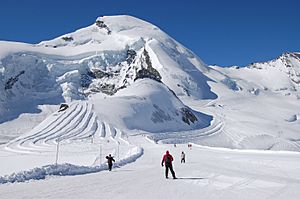
Skiing, snowboarding, and mountaineering are very popular sports in Switzerland. The country's many mountains are perfect for these activities. Bobsleigh was even invented in St. Moritz. The first world ski championships were held in Mürren (1931) and St. Moritz (1934). St. Moritz also hosted the Winter Olympic Games in 1928 and 1948. Famous Swiss skiers include Pirmin Zurbriggen and Didier Cuche.
Many Swiss people love football. The national team, called 'Nati', has many fans. Switzerland co-hosted the Euro 2008 tournament with Austria. Ice hockey is also very popular. Switzerland hosted the 2009 IIHF World Championship for the tenth time in 2009. The National League A is the most watched hockey league in Europe.
Switzerland's many lakes make it a great place for sailing. Lake Geneva is home to the Alinghi sailing team. They were the first European team to win the America's Cup in 2003 and won again in 2007. Tennis has also become more popular. Swiss players like Martina Hingis and Roger Federer have won many major tennis tournaments.
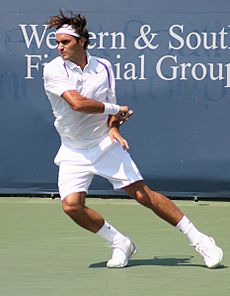
Motorsport events were banned in Switzerland after a big accident in 1955. This ban was lifted in 2007. Even with the ban, Switzerland had successful race car drivers like Clay Regazzoni and Alain Menu. Switzerland also won the A1GP World Cup of Motorsport in 2007–08. Swiss motorcycle racer Thomas Lüthi won the 2005 MotoGP World Championship in the 125cc class.
Traditional Swiss sports include Schwingen, which is a type of wrestling. It comes from the central cantons and some consider it the national sport. Hornussen is another unique Swiss sport, a mix of baseball and golf. Steinstossen is like shot put, where people throw a heavy stone. It has been practiced since the 13th century.
Swiss Food and Drink

Swiss food is very diverse. Some dishes, like fondue (melted cheese with bread), raclette (melted cheese served with potatoes), and rösti (fried grated potatoes), are popular everywhere. But each region has its own special foods based on its climate and languages. Traditional Swiss cooking uses ingredients common in Europe, plus unique dairy products and cheeses like Gruyère and Emmental.
Chocolate has been made in Switzerland since the 1700s. It became famous in the late 1800s with new techniques that made it very high quality. A big step was the invention of solid milk chocolate in 1875 by Daniel Peter. Swiss people eat more chocolate than anyone else in the world!
In the late 1800s, a Swiss health food pioneer named Maximilian Bircher-Benner created the famous Birchermüesli. It's a rolled oats cereal dish that was part of his nutrition-based therapy.
The most popular alcoholic drink in Switzerland is wine. Switzerland grows many different types of grapes. This is because the land has many different soils, altitudes, and light conditions. Swiss wine is mostly made in Valais, Vaud, Geneva, and Ticino. Most of the wine produced is white. People have been growing grapes in Switzerland since Roman times. The most common grape types are Chasselas and Pinot noir. In Ticino, Merlot is the main grape.
Related pages
Images for kids
-
The first Federal Palace in Bern (1857). Bern was chosen as the federal capital in 1848.
-
General Ulrich Wille, Commander-in-Chief of the Swiss Army during World War I
-
The Swiss Federal Council in 2016 with President Johann Schneider-Ammann (front, centre)
-
The Federal Palace, where the government and parliament meet.
-
The Landsgemeinde is an old form of direct democracy. It is still practised in two cantons.
-
A Swiss Air Force F/A-18 Hornet at Axalp Air Show
-
The Greater Zürich Area, home to 1.5 million inhabitants and 150,000 companies, is one of the most important economic centres in the world.
-
The Engadin Valley. Tourism is important for the alpine regions.
-
Some Swiss scientists who played a key role in their discipline (clockwise):Leonhard Euler (mathematics)Louis Agassiz (glaciology)Auguste Piccard (aeronautics)Albert Einstein (physics)
-
The campus of the Swiss Federal Institute of Technology Zurich (ETHZ).
-
The LHC tunnel. CERN is the world's largest laboratory and the birthplace of the World Wide Web.
-
Urbanisation in the Rhone Valley (outskirts of Sion)
-
Alphorn concert in Vals
-
Jean-Jacques Rousseau was an influential philosopher (his statue in Geneva).
-
The Switzerland national football team lining up against Argentina in 2012
See also
 In Spanish: Suiza para niños
In Spanish: Suiza para niños


